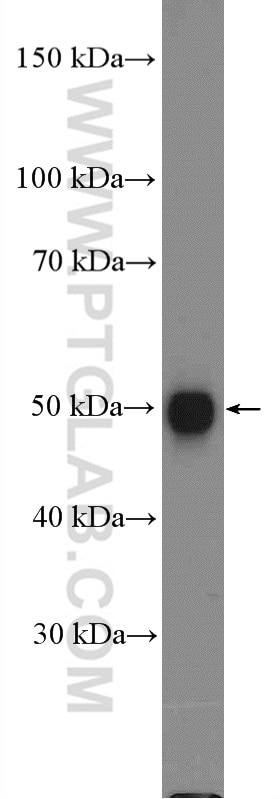Validation Data Gallery
Tested Applications
| Positive WB detected in | NCCIT cell |
Recommended dilution
| Application | Dilution |
|---|---|
| Western Blot (WB) | WB : 1:200-1:1000 |
| It is recommended that this reagent should be titrated in each testing system to obtain optimal results. | |
| Sample-dependent, Check data in validation data gallery. | |
Published Applications
| WB | See 1 publications below |
| IF | See 1 publications below |
Product Information
20744-1-AP targets SOX1 in WB, IF, ELISA applications and shows reactivity with human samples.
| Tested Reactivity | human |
| Cited Reactivity | human |
| Host / Isotype | Rabbit / IgG |
| Class | Polyclonal |
| Type | Antibody |
| Immunogen |
Peptide 相同性解析による交差性が予測される生物種 |
| Full Name | SRY (sex determining region Y)-box 1 |
| Calculated molecular weight | 39 kDa |
| Observed molecular weight | 45-50 kDa |
| GenBank accession number | NM_005986 |
| Gene Symbol | SOX1 |
| Gene ID (NCBI) | 6656 |
| RRID | AB_2878732 |
| Conjugate | Unconjugated |
| Form | |
| Form | Liquid |
| Purification Method | Antigen affinity purification |
| UNIPROT ID | O00570 |
| Storage Buffer | PBS with 0.02% sodium azide and 50% glycerol{{ptg:BufferTemp}}7.3 |
| Storage Conditions | Store at -20°C. Stable for one year after shipment. Aliquoting is unnecessary for -20oC storage. |
Background Information
Sox genes comprise a family of genes that are related to the mammalian sex determining gene SRY. These genes similarly contain sequences that encode for the HMG-box domain, which is responsible for the sequence-specific DNA-binding activity. Sox genes encode putative transcriptional regulators implicated in the decision of cell fates during development and the control of diverse developmental processes. SOX1 may function as a switch in neuronal development and Keeps neural cells undifferentiated by counteracting the activity of proneural proteins and suppresses neuronal differentiation.
Protocols
| Product Specific Protocols | |
|---|---|
| WB protocol for SOX1 antibody 20744-1-AP | Download protocol |
| Standard Protocols | |
|---|---|
| Click here to view our Standard Protocols |
Publications
| Species | Application | Title |
|---|---|---|
Mater Today Bio Nanofiber-microwell cell culture system for spatially patterned differentiation of pluripotent stem cells in 3D | ||
J Cell Mol Med Down-regulation of exosomal miR-200c derived from keratinocytes in vitiligo lesions suppresses melanogenesis. |

